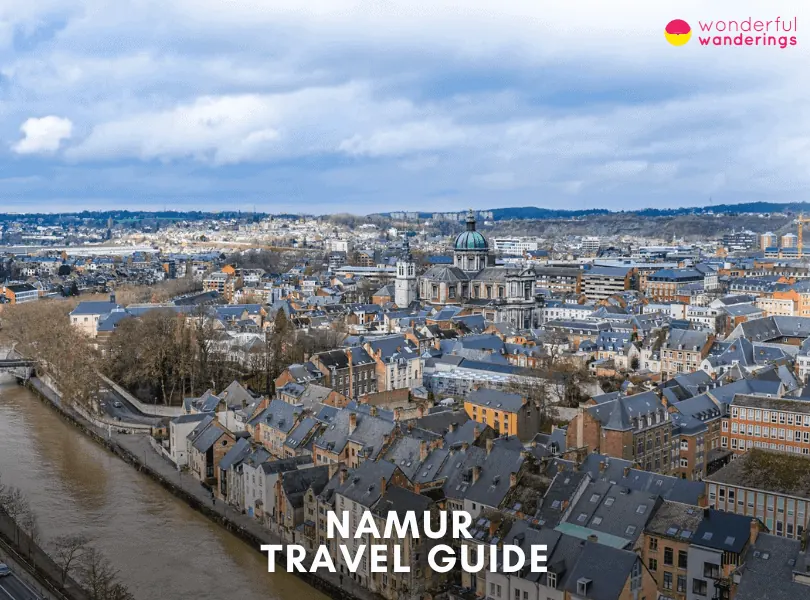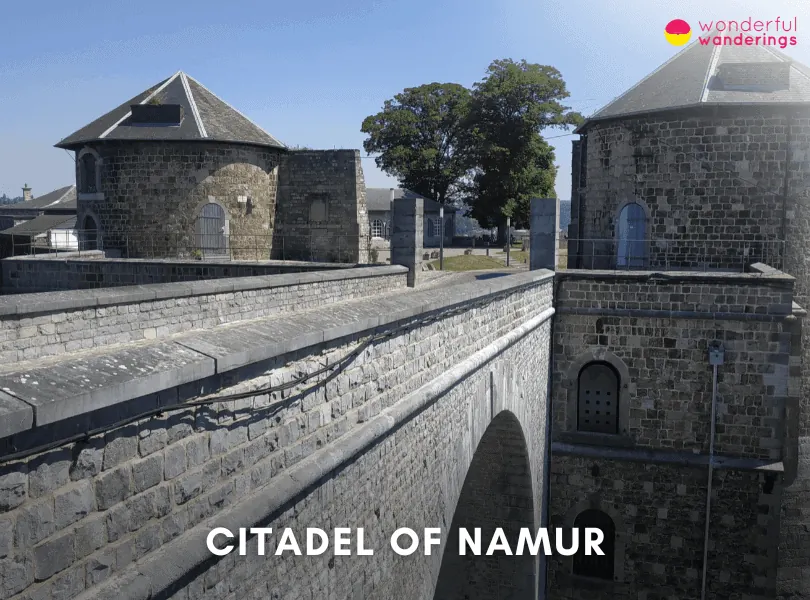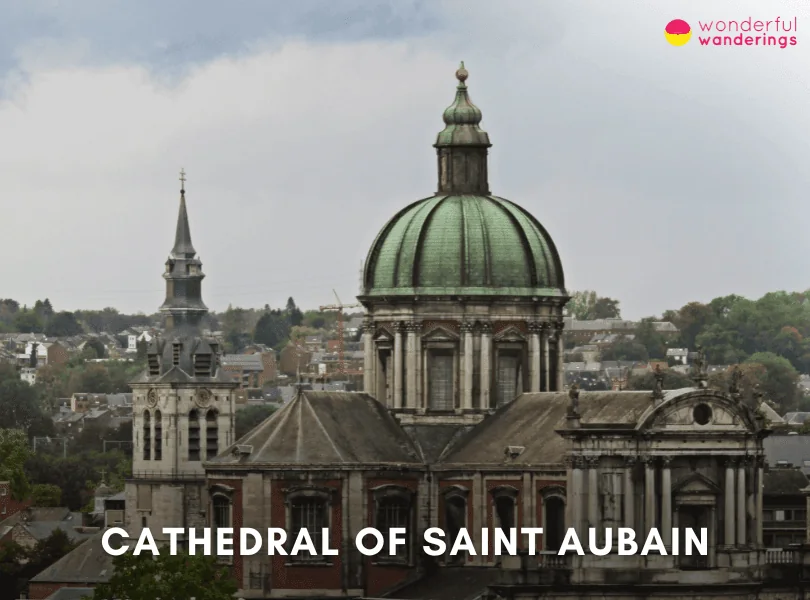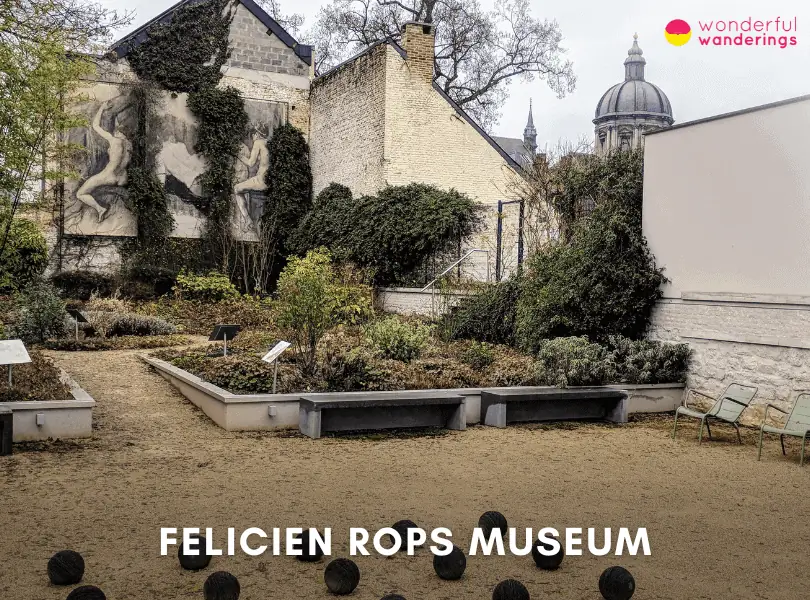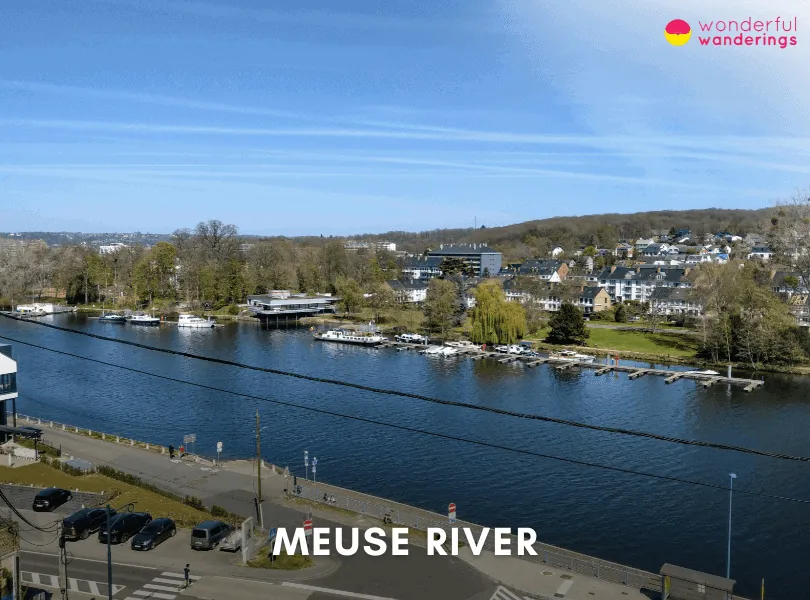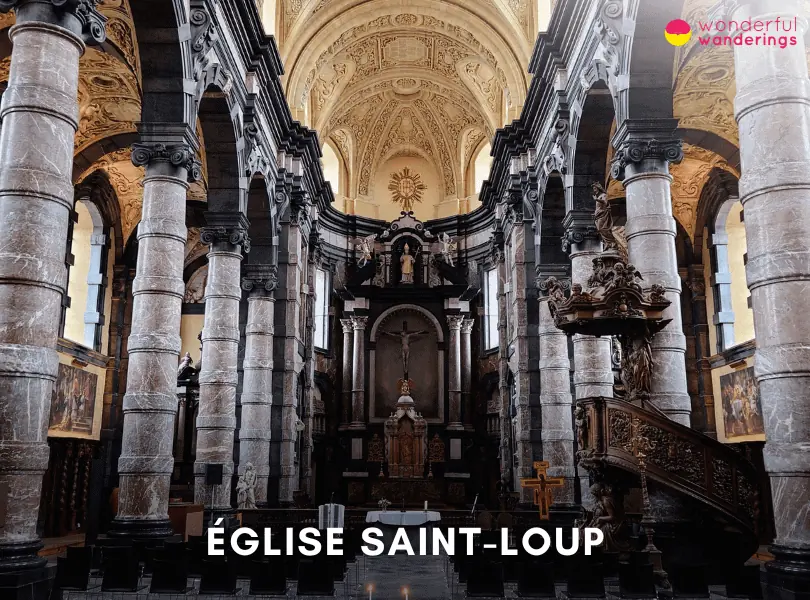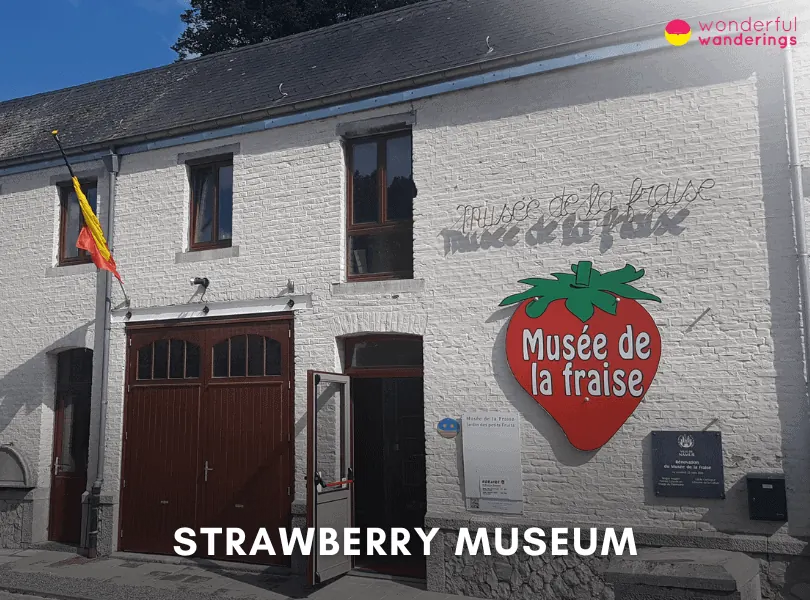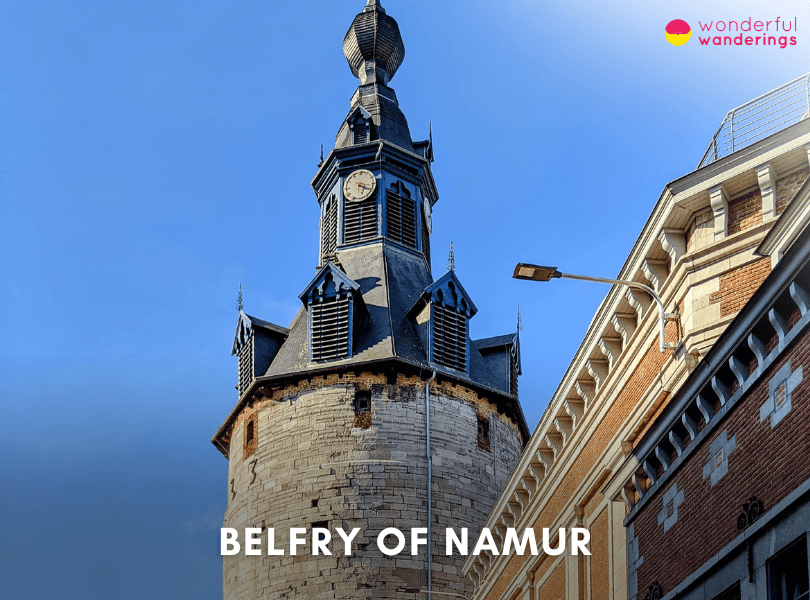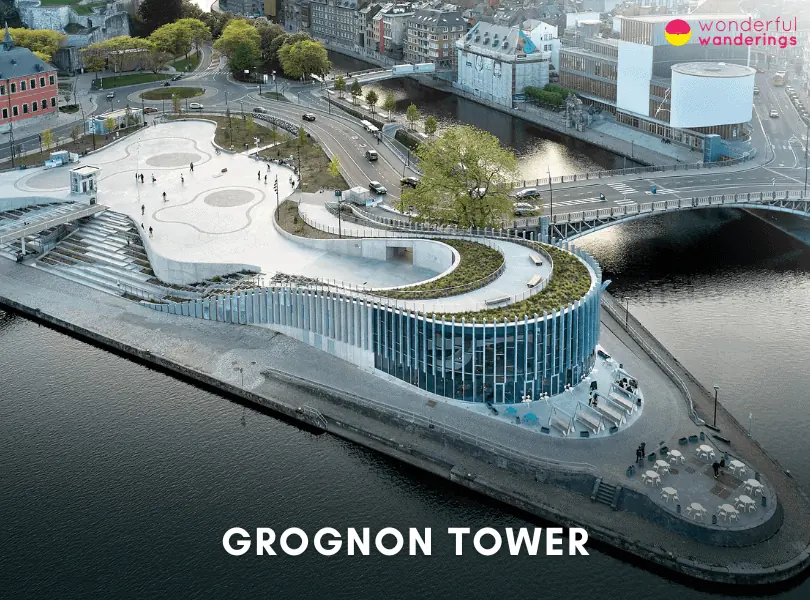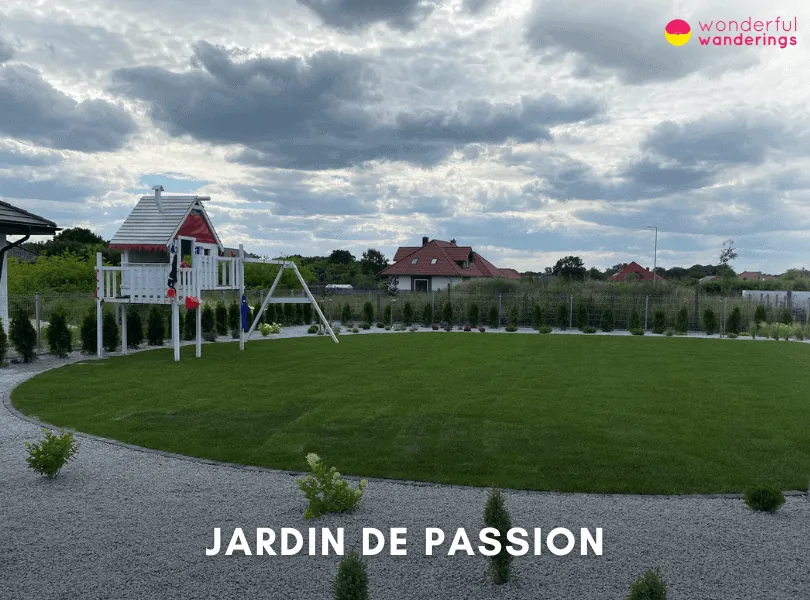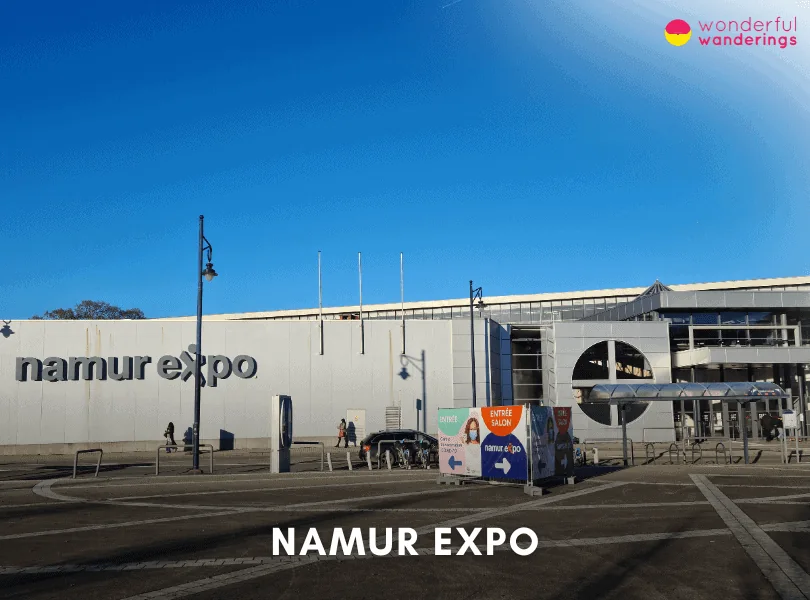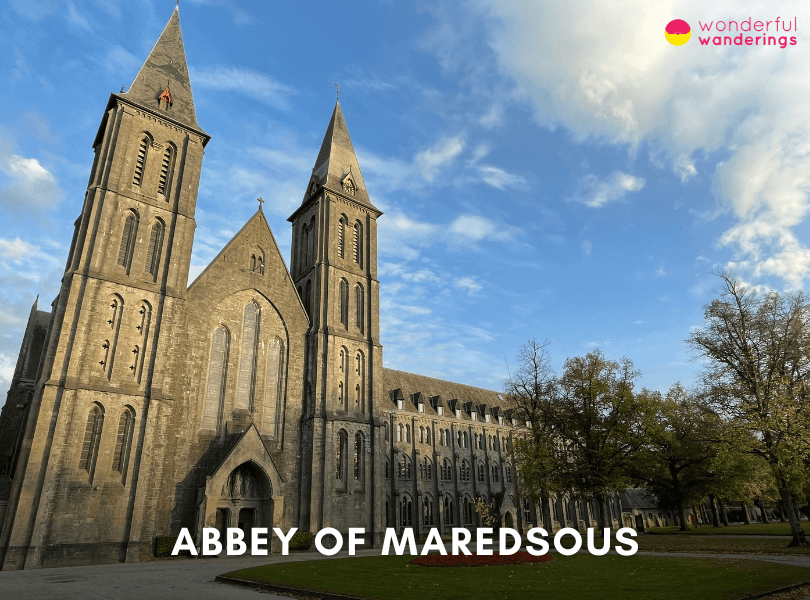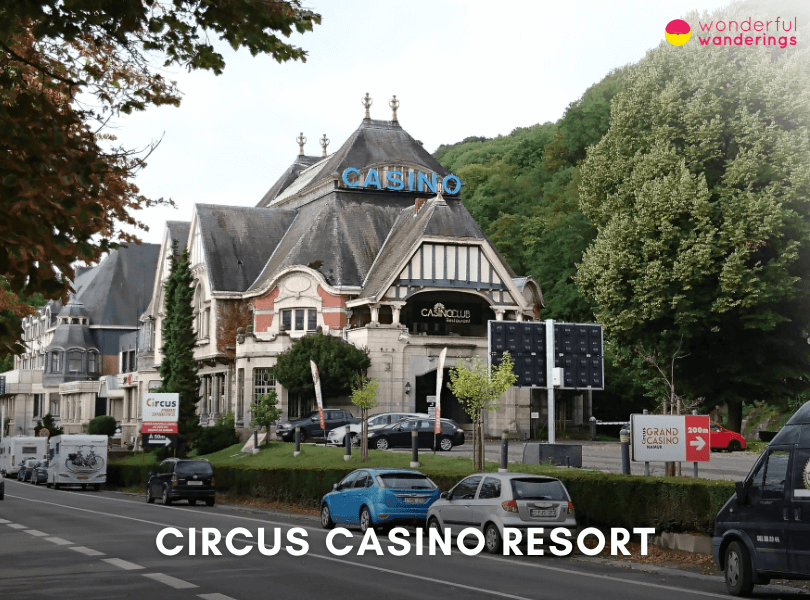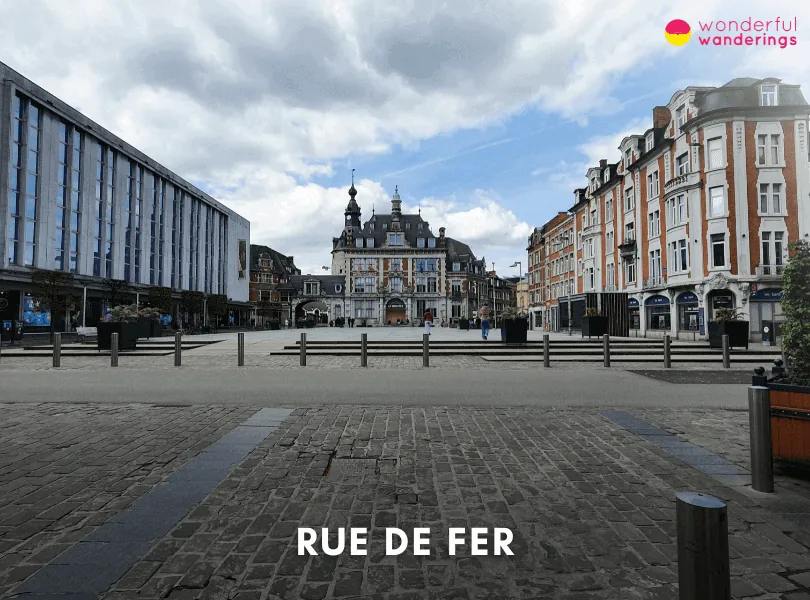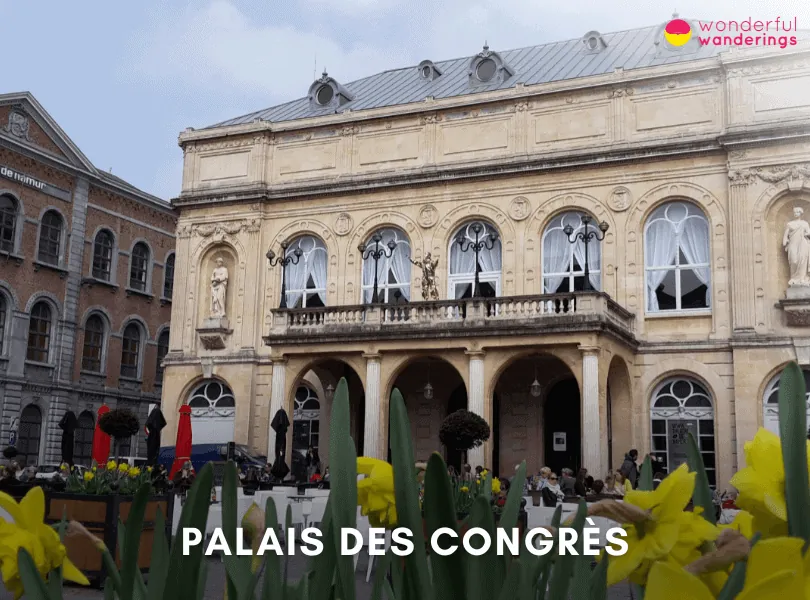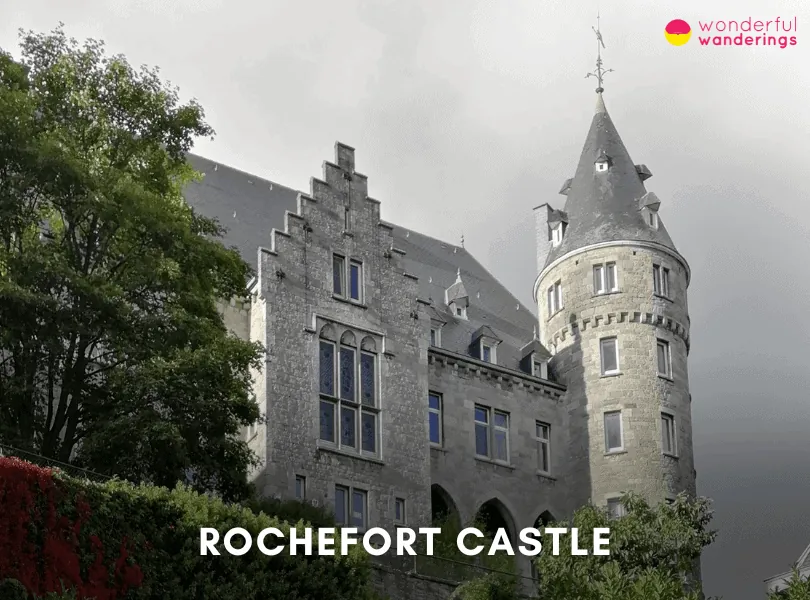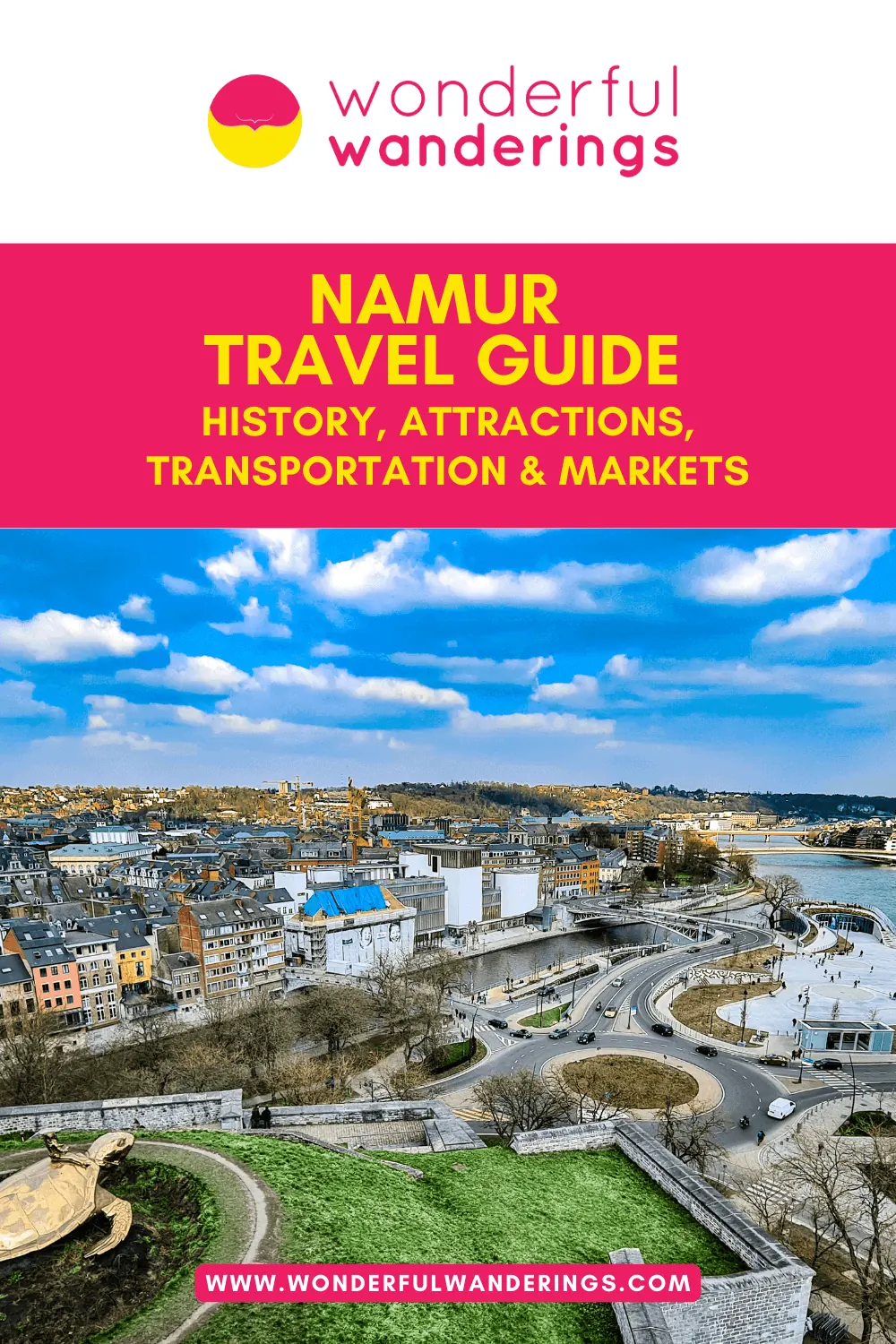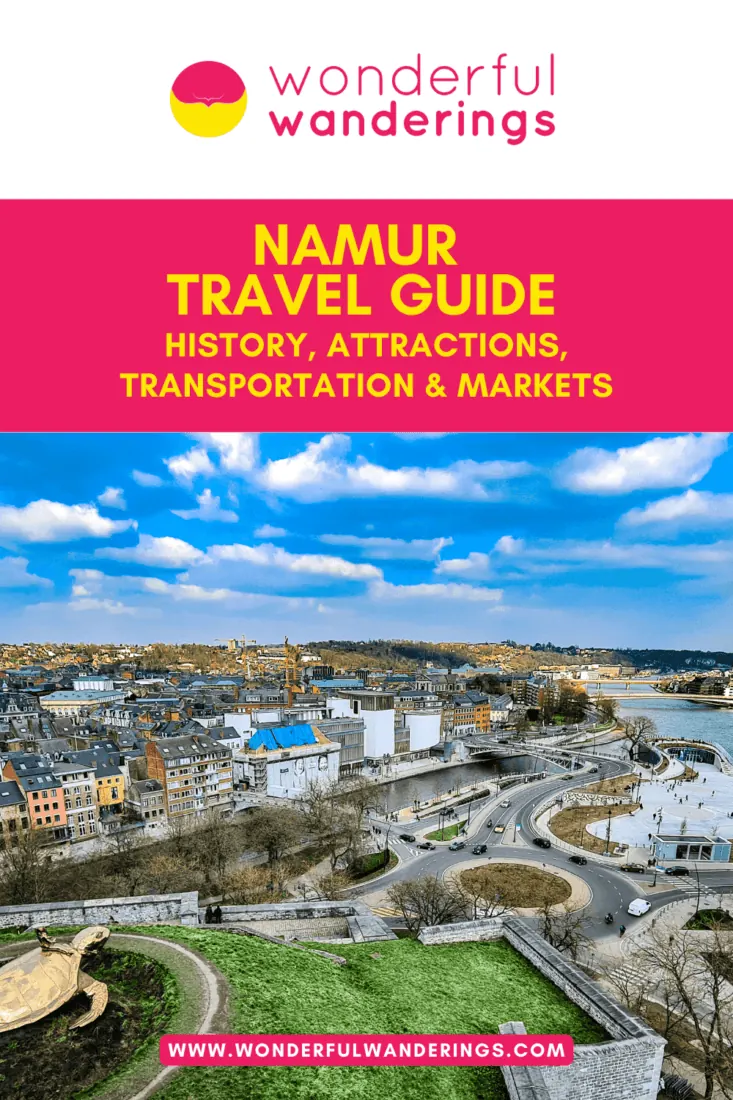Namur is the capital of Belgium’s Wallonia region, strategically situated at the confluence of the Meuse and Sambre rivers. This location has made Namur an important military and trade center since Roman times when it was fortified as a citadel. Over the centuries, Namur’s citadel and position along key waterways brought both prosperity and conflict as it was contested by European powers. Today, remnants of Namur’s past can be seen in sites like the imposing Citadel perched high above the rivers. Yet Namur also looks to the future with contemporary architecture like Grognon Tower embracing the riverside. Between history and innovation, visitors will discover Namur’s charm.
The city rewards exploration with scenic river views, excellent museums and a UNESCO-listed belfry. Namur’s status as the political capital of Wallonia also makes it a hub for the region’s arts and culture. When night falls, Namur’s restaurants and bars come alive. From the world-famous Trappist beers perfected nearby to Michelin-starred cuisine, Namur’s tastes span from rustic to refined. Namur provides the perfect introduction to Belgium’s francophone southern half. Its accessibility as a base to tour the Ardennes region only adds to Namur’s draw.
Listed below are the things to do in Namur, Belgium.
- Citadel of Namur. The Citadel of Namur is a historic fortress located in Namur, Belgium overlooking the confluence of the Sambre and Meuse Rivers. Over its history, the Citadel has been controlled by various powers including the Counts of Namur, the Spanish, Austrians and French. Today visitors can take guided tours of the underground tunnels, enjoy the views across Namur, visit the medieval garden, take an audiovisual history show and more. There is also a visitor center and cafes on site. Entry to the grounds is free. The Citadel can be reached via walking path, car or a cable car from Namur’s city center. Its history and sights appeal to visitors of all ages, especially those interested in military and history.
- Cathedral of Saint Aubain. The Cathedral of Saint Aubain, also known as Cathédrale Saint-Aubain, is a Roman Catholic cathedral located in central Namur, Belgium. The Cathedral contains artwork and decorations that contribute to its splendor, including gilded wood carvings, sculptures, paintings and a grand 1865 pipe organ. Visitors can admire the architecture and artwork, attend religious services or
visit the adjacent Diocesan Museum. The Cathedral is located just north of Namur’s city center and can be easily reached on foot. Admission is free, allowing budget travelers to take in its beauty. - Felicien Rops Museum. The Felicien Rops Museum is dedicated to the life and work of Belgian graphic artist and painter Felicien Rops (1833-1898). Located in an 18th century townhouse in central Namur where Rops was born, it contains the most comprehensive collection of his drawings, etchings, lithographs and paintings. The museum can easily be reached on foot in Namur’s old town about a 10 minute walk from the train station. It appeals most to visitors interested in 19th century art and Rops as a leading Belgian artist, though some works contain erotic imagery.
- Meuse River. The Meuse River flows through the city of Namur in Wallonia, Belgium, where it converges with the Sambre River. Visitors can enjoy scenic strolls, boat tours, riverside cafes and recreational activities like kayaking. The Meuse valley around Namur also provides opportunities to experience the river’s natural beauty by bike or on trails. Further upstream, the Meuse winds through picturesque towns like Dinant. Below Namur, it passes through Liege before leaving Wallonia near the Dutch border.
- Église Saint-Loup. The Église Saint-Loup is a prominent Catholic church located in central Namur, Belgium. Key features include its red marble columns, elaborate ceiling frescoes, ornate stucco decorations and carved wooden confessional boxes. The church contains various artwork including paintings and sculptures. Visitors can admire the architecture and artwork, attend religious services, enjoy concerts and find spots for prayer and contemplation. The interior is open on Saturdays and some Sundays/Wednesdays. Église Saint-Loup can easily be reached on foot in Namur’s old town near parking and about a 10 minute walk from the train station.
- Strawberry Museum. The Strawberry Museum (Musée de la Fraise) is located in Wépion, Belgium, around 8 km (4.97 miles) from Namur. Situated in a former villa along the Meuse River, the museum showcases the history and importance of strawberry farming in Wépion and the greater Meuse Valley across five exhibition rooms. The Strawberry Museum can be reached by car or bike and has free onsite parking. The museum is best suited for families, agricultural enthusiasts, gastronomy fans and those interested in specialized local history. Admission is 5 EUR for visitors ages 12 and up, free for children under 12.
- Belfry of Namur. The Belfry of Namur is a medieval tower located in central Namur, Belgium that is renowned for its architecture and clock. As one of Namur’s oldest non-religious buildings spanning over 600 years, the tower provides insight into medieval construction techniques and connects modern Namur to its past. The Belfry is located downtown near parking and public transportation options. Admission is free, allowing visitors to take in views of the tower and surrounding scenery at no cost.
- Grognon Tower. Grognon Tower is a contemporary cultural building located along the Meuse and Sambre rivers in central Namur. Visitors can also access the roof garden and riverside park. Grognon Tower offers tech-focused experiences suitable for all ages. Entry to the lobby, exterior terraces and park is free. Access to special events and tours inside may require paid admission.
- Jardin de Passion. Jardin de Passion is a one-hectare botanical garden located in central Namur, Belgium. Each garden uses artistic landscaping, sculptures, fragrant plants and signs to create an immersive sensory experience that engages visitors while teaching about historical plant uses. The garden’s unique concept combines botany, history and culture. Jardin de Passion can be easily reached by walking 10 minutes from Namur’s city center or taking local buses. It appeals to families, couples, gardeners and tourists interested in nature, botany, art and culture. Entry is free and does not require an admission ticket, allowing visitors to access the gardens anytime during open hours.
1. Citadel of Namur
The Citadel of Namur is a historic fortress located in the city of Namur, Belgium, overlooking the confluence of the Sambre and Meuse Rivers. It is located at Route Merveilleuse 64, 5000 Namur, Belgium. With over 7 km (4.3 miles) of underground tunnels, it is considered one of the largest fortresses in Europe. Over the centuries, the Citadel has been controlled by various powers including the Counts of Namur in the Middle Ages, the Spanish, the Austrians and the French. The current Citadel structure dates mainly from the 17th century when the site was expanded under Dutch control between 1631 and 1675. The Terra Nova section was added at this time to distinguish it from the smaller 16th century fort.
The panoramic views across Namur and the Meuse Valley are also stunning. Visitors to the Citadel can take guided tours of the underground tunnels, enjoy the audiovisual show bringing history to life and take in the views from the Tourist Train. There is also a Visitor Center with an interesting exhibit on the history of Namur and its Citadel. Visitors can explore the grounds, sites like the medieval garden and enjoy events held here throughout the year. There are cafes and restaurants on site as well.
Entry to explore the Citadel of Namur Grounds is free and it can be reached via a walking path, by car or by a cable car running from Namur city center directly to the Citadel esplanade. The activities at the Citadel would appeal to visitors of all ages, with particular interest for history and military buffs. Families would also enjoy exploring the tunnels, riding the tourist train, taking in the views and more.
2. Cathedral of Saint Aubain
The Cathedral of Saint Aubain also known as Cathédrale Saint-Aubain in French is a Roman Catholic cathedral located in Place Saint-Aubain 1, 5000 Namur. The Cathedral was constructed between 1617 and 1621 on the site of an earlier 11th century church. It became the seat of the Diocese of Namur in 1559. The Cathedral is dedicated to Saint Albinus of Angers and built in a classical style with baroque influences. It is considered one of the most important religious heritage sites in Wallonia.
The Cathedral of Saint Aubain is special for its ornate interior decorations and its impressive dome. The interior has a double colonnade lining the nave and aisles. There are intricate stucco decorations by the Moretti brothers depicting swags of fruit and flowers. The dome rises high above the crossing and is a landmark feature visible across Namur. The cathedral also contains gilded wood carvings, sculptures, paintings and other artwork that contribute to its splendor.
Visitors to the Cathedral can admire the beautiful architecture and decor, attend mass and other religious ceremonies or stop to pray and reflect. The Cathedral regularly hosts concerts, especially of classical music and organ recitals that highlight the grand pipe organ dating from 1865. Guided tours are sometimes available that provide insight into the history and artwork of the Cathedral.
In the Cathedral of Saint Aubain Complex, visitors can also explore the Diocesan Museum located to the right of the Cathedral. It contains religious artifacts, paintings, sculptures and liturgical objects from churches across the Diocese of Namur. Some notable pieces include works by Anthony van Dyck and other Flemish masters.
The Cathedral of Saint Aubain can be easily reached on foot if staying in central Namur, as it sits just north of the city center. For those coming by car, there is metered parking available on the streets around the Cathedral. The nearest train station is Namur Station, about a 12 minute walk away. Admission to the Cathedral itself is free, allowing budget travelers to take in its beauty freely. The modest fee for the Diocesan Museum makes it accessible to most.
3. Felicien Rops Museum
The Felicien Rops Museum is dedicated to the life and work of Belgian graphic artist and painter Felicien Rops. It is located in the heart of the old town of Namur at Rue Fumal 12, 5000 Namur, Belgium. The museum is housed in an 18th century former townhouse not far from where Rops was born in 1833. It contains the most comprehensive collection of his drawings, etchings, lithographs and paintings. Rops was part of the Symbolist movement and was known for his satirical, erotic and macabre works.
The museum aims to provide an overview of Rops’ career from his early work as a caricaturist to his later more daring pieces. The collection and exhibits are arranged chronologically and thematically to showcase the different periods and facets of his oeuvre. Key themes explored include his time in Brussels, his rise to fame in Paris, his depictions of women and his focus on love, desire and death. The museum also has an interesting collection of letters, photographs and personal effects that provide insight into Rops’ influences and personality.
Visitors can explore the permanent collection with an audio guide available in four languages. Temporary exhibitions focused on related topics or artists are also regularly hosted. Guided tours can be booked for groups. The museum occasionally organizes lectures, concerts and film screenings as well. There is a gift shop selling books and souvenirs.
The Felicien Rops Museum can easily be reached on foot if staying in central Namur. It is about a 10 minute walk from the train station. There is metered street parking nearby. For those traveling by car, the E411 and E42 motorways provide direct access to Namur from other cities in Belgium.
Felicien Rops Museum appeals most to visitors interested in art history, especially 19th century graphic arts and the Symbolist movement. It provides a fascinating look at one of Belgium’s most renowned artists. The works may not be suitable for young children due to some erotic and occult imagery. Admission is €3 for access to the permanent collection. Special rates are available for students, seniors and groups. Temporary exhibitions usually cost extra.
4. Meuse River
The Meuse River is one of the major rivers of Europe, rising in France and flowing through Belgium and the Netherlands before draining into the North Sea. In Belgium, the Meuse passes through Wallonia, including the city of Namur which sits at the confluence of the Meuse and Sambre Rivers. The Meuse has played an integral role in the history and development of Namur. The river’s convergence with the Sambre at Namur created a strategic position that led to the original settlement and fortification of the site by the Romans. Control of this strategic spot at the crossroads of the two rivers has been contested by various powers across history.
The river banks in central Namur offer beautiful views across the river to the citadel. Visitors can relax at riverside cafes and restaurants, take scenic strolls or take boat tours along the Meuse. The Meuse Valley around Namur provides additional vistas and recreational opportunities. Bike paths and trails along both sides of the river allow visitors to take in riverside scenery. The Meuse also enables water sports like kayaking, canoeing and stand-up paddleboarding in Namur.
Upstream from Namur, the Meuse winds through picturesque towns like Dinant that cling to the rocky cliffs lining the river. Below Namur, the river passes through the old provincial capital of Liege before leaving Wallonia near the Dutch border on its way to join the Rhine.
The Meuse River has been an integral natural feature shaping Namur’s landscape, history, commerce and culture for over 2000 years. Visitors today can embrace the river through sightseeing, dining, recreation or relaxation along its scenic banks in the heart of the city. Its valley also provides opportunities to experience the river’s natural beauty. For tourists, the Meuse is an iconic symbol of Namur and Wallonia.
5. Église Saint-Loup
The Église Saint-Loup or Saint Loup Church is a prominent Catholic church located in Rue du Collège 4, 5000 Namur, Belgium. Originally built in 1621 as the Jesuit church of Saint-Ignace, it was renamed Église Saint-Loup after the Jesuits were banned from Namur in 1777. The church is dedicated to Saint Loup of Troyes, an early medieval bishop and saint. Église Saint-Loup is considered one of the most beautiful and important Baroque buildings in Belgium. Key features include its red marble columns, elaborate ceiling frescoes, ornate stucco decorations and carved wooden confessional boxes.
Église Saint-Loup special is the opportunity to discover the expressive style of the Baroque through its well-preserved interior decorations. The church also contains various artwork including paintings, sculptures and liturgical objects, some notable pieces being works by Flemish masters such as Anthony van Dyck.
Visitors can admire the beautiful architecture and artwork inside Saint-Loup Church, attend mass and other religious ceremonies, enjoy concerts held here and find a peaceful spot for prayer and contemplation. The church interior is open to the public on Saturdays and some Sundays/Wednesdays. Guided tours can be booked for groups interested to learn more about the history and heritage. There are also special events like lectures, concerts and film screenings occasionally hosted.
The church can easily be reached on foot when staying in central Namur, with the nearest parking about a 5 minute walk away. Its central location in the old town makes it a convenient stop while exploring Namur’s historic sights.
For those traveling by car, there is metered street parking available nearby. The main train station is about a 10 minute walk away. The church’s proximity to Namur’s tourist sites and transport links makes it very accessible for visitors. The church’s central location also draws casual visitors just wandering through old town Namur.
Admission to enter and view Église Saint-Loup is free. Donations are welcome to contribute to its preservation. Special activities like concerts or tours may have separate pricing. But the iconic church itself is openly accessible to all visitors respecting its heritage.
6. Strawberry Museum
The Strawberry Museum also known as Musée de la Fraise in French is a museum located in Chaussée de Dinant 1037, 5100 Wépion, Belgium. Situated in a former villa along the banks of the Meuse River, the museum features five exhibition rooms that showcase the strawberry’s importance to the area over time. Beyond the main museum, the Strawberry Museum complex also encompasses a 35-acre garden with over 20 types of local fruit trees and berries, 15 varieties of strawberries, an orchard showcasing native fruit varieties and beehives for small-scale honey production. The museum aims to provide a comprehensive look at the legacy and modern practice of strawberry farming in Wépion and the greater Meuse Valley.
Visitors to the Strawberry Museum can take a self-guided or guided tour through 5 exhibition rooms detailing the history of strawberry farming in Wépion and tasting over 15 varieties of strawberries. They can explore 35 acres of berry gardens with 20 types of fruit trees and 15 strawberry varieties. Visit the orchard area to see different native fruit tree varieties and purchase strawberry plants, local fruit products like jams and juices and other souvenirs at the museum gift shop.
The Strawberry Museum is accessible by both car and bike. Free parking is available onsite for visitors arriving by car. For those coming by bike, the museum grounds are bike-friendly. Visitors who own a car from Namur can take the E411 heading south, take exit 8 signposted for Wépion, turn right off the exit onto Rue de Dave in the direction of Wépion center. After approximately 1 mile, turn left onto Chaussée de Dinant and the Strawberry Museum entrance will be on the right after 0.3 miles. The nearest train station is Namur Station, located 8 km (5 miles) away. From there, buses are available that stop within a 12 minute walk from the museum or taxis can be taken directly from the station to the museum.
The Strawberry Museum is best suited for families with kids, agricultural enthusiasts, gastronomy connoisseurs and visitors interested in specialized local history. The museum’s interactive exhibits, onsite gardens, fruit tastings and products make it an engaging destination for children and adults alike. People wanting an educational and tasty experience related to Wépion’s storied strawberry farming legacy would appreciate this museum. The Strawberry Museum has an admission cost of 5 EUR (or about $5.30 USD) for visitors ages 12 and up. Children under 12 can enter free of charge when accompanied by an adult. Guided tours are available for an added fee by reservation.
7. Belfry of Namur
The Belfry of Namur, also known as the Tour Saint-Jacques, is a medieval tower and landmark located on Rue du Beffroi, 5000 Namur, Belgium. Originally built in 1388 as part of the city’s fortifications, the circular limestone tower stands approximately 20 meters (65 ft) tall and was equipped with a bell in the 16th century to signal the opening and closing of the town gate 1. After Namur’s main church, Saint-Pierre-au-Château, was destroyed in 1745, The Belfry took on a more civic role and officially became the city’s belfry in 1746. The tower is renowned for its architecture and clock.
As one of the oldest non-religious buildings in Namur, it provides insight into medieval construction. And its ongoing civic function over 600+ years connects modern Namur to its past. The Belfry’s iconic presence at the heart of the capital makes it a symbol of the city’s identity. Visitors to The Belfry of Namur can see the tower’s clock and famous 1733 inscription up close. They can go inside the adjacent Beffroi Gallery to view temporary art exhibitions.
The Belfry is centrally located in downtown Namur and accessible by car, public transportation or by foot. Parking garages are available a 5-10 minute walk away and Namur’s main train station is just over 1 km (0.6 miles) away. Several buses stop along the downtown roads by the Belfry and it is easily walkable from shops/attractions near the town center.
The Belfry of Namur seems most appealing to adult travelers interested in architecture, history and culture. However, its iconic look and central location in front of Namur’s picturesque plaza make it eye catching and enjoyable for visitors of all ages even just to view and take photos next to. There is no cost or admission ticket required to view The Belfry of Namur from the outside. Visitors can take in sights of the tower itself and surrounding scenery for free. There is also no cost to go into the Beffroi Gallery located adjacent to the tower.
8. Grognon Tower
Grognon Tower, also known as the Grognon Exhibition Space, is a contemporary cultural building located at Rue du Grognon 2, 5000 Namur, Belgium. It sits adjacent to Namur’s historic Roman citadel, across from the Wallonian Parliament building, at the meeting point of the Meuse and Sambre rivers in the heart of the city. It was designed by the architecture firm 3XN and completed in 2021. The organically-shaped building focuses on the history and innovation of digital technologies, providing a space for activities and experiences where modern technologies are made available to the public.
The historic park continues on top of the building, with its green roof sloping down towards the Meuse River. This creates a series of terraced public spaces and wide steps planted with grass, intended for urban events and performances.
Visitors to Grognon Tower can attend exhibitions, conferences, presentations focused on digital technology and innovation. They can participate in hands-on activities and workshops utilizing modern technologies. Walk on the accessible green roof and take in views of the rivers and city, they can stroll through the terraced riverside park and pathways, Visitors can experience the seamless connection between interior and exterior spaces.
Grognon Tower can be reached by walking along the pedestrian walkway and tunnel from Namur city center. Taking local public transport which is located between the Grognon and Théâtre stops on bus lines 1, 2, 3, 4 and 5.
Grognon Tower offers experiences suitable for people of all ages and interests. Families can enjoy the outdoor terraced landscape, cafe and accessible green roof. Kids are welcomed to technology workshops and hands-on learning activities. Teens and young adults can experience events, concerts and modern tech.
Entry to Grognon Tower’s lobby, exterior terraces and riverside park is free and open to the public. Access to special exhibitions, events and activities inside the multi-purpose hall may require paid admission, with ticket prices varying based on the specific event. Guided tours for groups and school groups are also available by reservation for a fee.
9. Jardin de Passion
Jardin de Passion is a botanical garden located in Boulevard Frère Orban, 5000 Namur, Belgium. Covering about 1 hectare, it was designed by landscape architect Jean Chalon and opened to the public in 1995. The garden contains over 300 different plant species laid out to represent concepts like sacred trees, alchemist’s plants and inspired flowers. Each area uses artistic landscaping, sculptures, fragrant plants and informational signs to create an immersive experience that engages the senses while teaching about the historical uses of plants.
Jardin de Passion special is an educational concept combining botany, history and culture through 12 themed gardens. It has artistic landscaping and sculptures integrated into the plant designs. Variety of rare and common plants from around the world. Visitors to Jardin de Passion can stroll through the 12 themed garden sections at their own pace and photograph unique plant specimens and garden vistas.
Jardin de Passion can easily be reached by walking from Namur’s city center, about 10 minutes across the bridge. By also taking local bus lines 1, 2, 3, 4, 5 to the Louise-Marie stop. Driving to available public parking areas around Louise-Marie Park and access through the main gates of Louise-Marie Park on Boulevard Frère Orban.
Jardin de Passion appeals to families, couples and individuals of all ages looking to take a peaceful nature walk. Tourists interested in botany, gardens, art and culture and students and gardeners who want to learn about plant species and uses. Entry to Jardin de Passion is completely free and does not require any admission cost. Visitors can access the garden anytime during open hours. Guided tours for groups are available by advance request for a fee.
10. Namur Expo
Namur Expo is the main exhibition and convention center located in Avenue Sergent Vrithoff 2, 5000 Namur, Belgium. Formerly known as the Palais des Expositions de Namur, it is owned by the Province’s Economic Development Agency and offers over 12,000 sqm of flexible space to host various events. The facilities include two large exhibition halls fully equipped with technical services, modular conference rooms, a large auditorium and two catering areas.
Namur Expo hosts around 20 fairs and exhibitions annually, welcoming over 200,000 visitors per year. Some of the most prestigious fairs held at Namur Expo are Antica Namur, an art and antiques fair and Bois & Habitat, a home improvement and construction fair. Conferences, concerts, business meetings and community events also take place in the venues throughout the year.
Some key features that make Namur Expo stand out are its prime location in the city center near hotels, restaurants and attractions. The flexible exhibition halls with over 12,000 sqm of space and integrated conference facilities for seminars and meetings. Visitors can attend trade shows, exhibitions, conferences and events held in the venues. They can browse exhibitor stands showcasing products and services, participate in workshops, presentations and hands-on activities. Watch product demonstrations and entertainment performances on stage.
Namur Expo can easily be accessed by car via the E42, E411 and N4, N5, N95 highways, with parking onsite. Visitors can take the train to Namur Station, just minutes away and local bus lines 1, 2, 3, 4, 5 stopping at Namur Expo. Walking from the city center in about 10-15 minutes.
Admission fees vary depending on the specific event. Large public exhibitions typically charge an entrance fee, while access to trade shows is usually free for registered attendees. Guided tours and auditorium performances also require paid tickets. Visitors should check with the organizer of each event for details on ticket pricing. General access to the lobby and facilities is free.
11. Abbey of Maredsous
The Abbey of Maredsous is a Benedictine monastery located in Rue de Maredsous 11, 5537 Denée, Belgium. Founded in 1872, the abbey was built in a neo-Gothic architectural style and consists of the church, cloister, monastery, library, old school of artistic crafts and guesthouse. The monks work in various roles – some teach, work in the bookshop or scientific research, make cheese, welcome visitors, etc. The abbey has been a center of arts, crafts and publishing since 1882. It published the first French-Latin missal and a French translation of the Bible. Today it continues producing books, exhibitions and biblical multimedia. The abbey is known for studies in patristics, liturgy and monastic traditions. It also has an art school focused on goldwork, ebony carving and ceramics.
Abbey of Maredsous has a long Benedictine tradition since 1872, with daily monastic life continuing today; Beautiful neo-Gothic architecture and tranquil natural setting; Reputation as a center of arts, crafts, publishing and scholarship; Production of the famous Maredsous cheeses and beers; Warm hospitality and accessible visitor facilities like the museum, bookshop, restaurant and guesthouse open to the public; Location within the picturesque Molignée valley and Ardennes countryside.
Visitors to the Abbey of Maredsous can take a guided tour of the abbey church, cloister, cemetery, gardens. They can purchase cheeses, beers, breads and products at the gift shop. Pray and meditate in the quiet church atmosphere and stay overnight at the guesthouse for a peaceful retreat. Visitors can relax at the St. Joseph cafeteria and restaurant.
The Abbey of Maredsous can be reached by car via the E411 motorway, exiting at Denée to follow signs to the abbey, Train to Namur or Dinant station, then taxi or bus 21 to Denée. They can take a Bus 21 from Namur that stops right at the abbey grounds. Walking or cycling along marked trails through the Molignée valley.
12. Circus Casino Resort
Circus Casino Resort is a casino and hotel complex located at 1 Avenue Baron de Moreau, 5000 Namur, Belgium. Opened in 2021, it is Belgium’s first casino resort featuring a mix of gaming, lodging, dining and
entertainment options. The interior features luxurious, elegant decor and spaces. It houses the Grand Casino with over 250 slot machines, traditional table games and tournament poker. Facilities also include the “La Carte du Roi” bistronomic restaurant, two wellness centers with hammams, saunas and jacuzzis, a bar, four meeting rooms and a large conference hall.
The most notable thing that makes Circus Casino Resort unique is that it is Belgium’s first casino resort, integrating gaming, hotels, dining and entertainment all in one destination. Circus Casino Resort contains the largest casino in Namur with modern slot machines and table games. It also provides rejuvenating wellness centers with spa treatments.
Circus Casino Resort can easily be accessed by car via the E46/A15 motorway, exit “Namur Centre”, with parking onsite. Train to Namur Central Station, a 5-10 minute walk away. Local bus lines 1, 2, 3, 4, 5 stopping at the Casino bus stop and walking into central Namur in just 10-15 minutes.
Entry to Circus Casino Resort’s lobby, exterior terraces and promenade is free. Gambling in the Grand Casino is open to ages 21+ with a valid ID. Hotel room rates, restaurant dining, spa treatments and special events each have separate pricing. Guided tours and venue rentals also cost additional fees. Visitors should check with the venue regarding specific event ticket prices.
13. Rue de Fer
Rue de Fer is a cobblestone street located in Rue du Pont, 5000 Namur, Belgium. Rue de Fer translates to “Iron Street” in English, which is an apt name for this historic street.
Rue de Fer is renowned as one of the most beautiful streets in Namur, making it a top attraction for visitors. The street is lined with charming 17th and 18th century houses, many of which have been lovingly restored.
One of the main highlights along Rue de Fer is the Belfry of Namur, a UNESCO World Heritage Site. The Belfry was built in 1388 and stands at the center of the street as its most recognizable landmark. Visitors can tour the Belfry and climb to the top for panoramic views over Namur. The street is also home to the 18th century St. Loup Church, known for its Baroque interior and Rococo pulpit. Visitors strolling along Rue de Fer will discover art galleries, cafes, restaurants and local shops housed within the storybook buildings.
Rue de Fer is located right in the heart of downtown Namur, making it very easy to access. Namur is only a 1 hour train ride from Brussels. The street can be reached by foot from Namur’s main train station in just 10 minutes. Driving to Rue de Fer only takes 5 minutes from the E46 motorway. Free public parking is available at Parking du Grognon, just steps away from Rue de Fer’s northern end.
The street can be enjoyed by visitors of all ages and interests. Its pedestrian zone provides a safe place for children to roam freely. Photographers are drawn to its camera-ready facades. Best of all, strolling Rue de Fer and taking in the sights is free for everyone. The only costs are for optional activities like touring the Belfry or dining in one of the restaurants along the charming street.
14. Palais des Congrès
The Palais des Congrès is a modern convention center located in Avenue de la Plante 23, 5000 Namur, Belgium. The Palais des Congrès is conveniently situated right next to the River Meuse in Namur. It is part of Namur Expo, a larger complex that also contains the Namur Exhibition Center. The main portion of the Palais des Congrès contains a large, flexible auditorium space that can accommodate up to 1,800 people. The auditorium has a stage, advanced audiovisual capabilities and tiered seating that can be configured based on each event’s needs. There are also several smaller conference rooms outfitted with the latest technology.
The Palais des Congrès offers over 7,000 square meters of event space. The spaces feature soaring ceilings, abundant natural light and minimalist contemporary architecture. The Palais des Congrès is specially designed to host large conferences, corporate meetings, trade shows and other major events that require ample space. The expansive exhibition hall and auditorium allow the center to accommodate thousands of attendees. The Palais des Congrès offers built-in rigging, catering facilities, free WiFi and advanced technical amenities to support major events.
Visitors to the Palais des Congrès can attend conferences, exhibitions, concerts and shows hosted in the spaces. The center’s calendar of public events includes musical performances, business expos, job fairs and more. Guided tours of the Palais des Congrès are also available for those interested in seeing the architecture and event facilities. When not booked for private events, the public can explore parts of the venue.
The Palais des Congrès is located just a 5-10 minute walk from Namur Railway Station. It is right off the E46 motorway, providing easy highway access. There is ample parking available at the venue and nearby public lots. Namur city center and its abundance of hotels and restaurants are conveniently located about 1 km (0.6 miles) away.
The modern, flexible spaces are suitable for events of all types and sizes. The Palais des Congrès can accommodate small meetings for a dozen people up to major conferences with thousands of attendees. The neutral decor and state-of-the-art amenities make it an ideal venue for corporate events, trade shows, galas and more. Admission costs vary based on the type of event and space requirements.
15. Rochefort Castle
Rochefort Castle is a medieval castle located along the Lomme River at the address Place de l’Eglise 1, 5580 Rochefort, Belgium. The castle dates back to the 11th century and stands out for its unique blend of architectural styles accumulated over the centuries. The castle was built atop a rocky promontory overlooking the Lomme River Valley, which allowed it to control an important strategic route through the Ardennes region. It was constructed out of local materials like sandstone and schist.
The château has imposing cylindrical towers at the corners and ornate windows in the typical Renaissance style. Visitors can tour the château’s lavish interior rooms, such as the Grand Salon with its coffered ceilings and colossal fireplace. There is also an elegant French-style garden on the grounds. The older castle ruins include remnants of the keep, curtain walls and 13th century towers. Visitors can climb up the ancient ramparts and take in panoramic views of the river valley below. The ruins have been partially restored and consolidated for safety while preserving their authentic weathered appearance. Signage helps visitors visualize what the original medieval fortress looked like throughout its long history.
Visitors to Rochefort Castle can explore its many museums and attractions. There is a museum of modern art featuring works by Belgian artists. Another museum focuses on the castle’s medieval military history, with exhibits of arms and armor. The stables have been converted into an exhibit highlighting Rochefort’s rural traditions and local crafts. Special events held at the castle include a medieval Christmas market each December.
Rochefort Castle is located about 1.5 hours by car from Brussels or 30 minutes from Namur. The nearest train station is in Jemelle, a 10 minute drive away. Free parking is available adjacent to the castle. The castle grounds are open year-round except on Mondays and major Belgian holidays.
The multi-faceted attractions make Rochefort Castle appealing for visitors of all ages. Families can enjoy exploring the ramparts and gardens. History buffs will appreciate learning about its architectural evolution. Fans of the Middle Ages can picture the castle’s medieval heyday. Admission ranges from 7 to 10 Euros depending on if visitors tour the château, gardens and special exhibits.
Where is Namur?
Namur is the capital city of the Wallonia region in Belgium. Located at the confluence of the rivers Meuse and Sambre, it is an important economic and cultural hub in the country. It is close to other significant cities such as Brussels and Liège and is strategically positioned in the Belgian landscape. Namur has been an important political and military significance centre with a rich history dating back to Roman times. The city is widely recognised for its charming squares, historical architecture and vibrant cultural scene. It spans an area of 175.69 square km (109.23 miles), offering a splendid mix of natural beauty and urban sophistication.
What is the history of Namur?
Namur is a city located in the Walloon Region of southern Belgium. It has an extensive history dating back to pre-Roman times. Celtic tribes such as the Treveri originally inhabited the area around the confluence of the Sambre and Meuse rivers where Namur now stands. The Romans conquered the region around 50 BC and built a settlement called Aduatuca Tungrorum on present-day Namur. After the collapse of the Roman Empire, Namur came under the control of the Merovingians and later the Carolingians. In the Middle Ages, Namur became a crucial defensive site and the county of Namur was established here. A castle was built to protect the city. Namur was caught between competing powers during this period. It was ruled at different times by the Dukes of Burgundy, the Dukes of Brabant and the Counts of Flanders. In 1421, Philip the Good, Duke of Burgundy, purchased Namur and added it to his Burgundian lands. After the Burgundian Netherlands passed to the Habsburgs in the 15th century, Namur continued to hold strategic importance. Namur’s defences were strengthened with new fortifications designed by Donato Bramante. However, the French repeatedly besieged Namur during the 16th and 17th centuries during the Wars of Religion and the later Franco-Dutch Wars. The city was briefly under Spanish control in the 17th century before being definitively captured by the French in 1692 during the Nine Years’ War. Namur remained under French control until the end of the 18th century. It was captured by the Prussians during the War of the First Coalition in 1794. After the defeat of Napoleon, Namur became part of the United Kingdom of the Netherlands. With Belgian independence in 1830, Namur became part of the new Belgian state. During the 20th century, Namur became an administrative and commercial centre in Belgium’s Ardennes and Wallonia regions. Its history spans over 2,000 years of European development.
What language is spoken in Namur?
The primary language spoken in Namur is French. In Namur, as in the wider Wallonia region of Belgium, the populace predominantly communicates using French. This is a testament to the region’s historical and cultural affiliations with Romance-speaking communities. The education system and media in Namur predominantly operate in French and the city’s residents generally possess a high level of proficiency in the language. Being a part of a multilingual country, it is not uncommon to find individuals proficient in other languages, such as Dutch or English, facilitating broader communication and cultural exchange within Belgium and with neighboring countries. Visitors should have a working knowledge of French to navigate daily interactions easily.
What timezone is Namur on?
Namur is in the Central European Time (CET) zone. Geographically, this city in Belgium is aligned with the time zone, which covers many parts of Central Europe. During the winter months, Namur observes standard time, Central European Standard Time (CET), which is 1 hour ahead of Coordinated Universal Time (UTC+1). From the last Sunday in March until the last Sunday in October, daylight saving time is observed and the clock is adjusted to Central European Summer Time (CEST), which is UTC+2. This adjustment helps in making better use of natural daylight during the evenings. Switching between standard time and daylight saving time is quite common in many European countries, aiding energy conservation and aligning with regional daylight patterns.
What are the most interesting facts about Namur?
Listed below are the most interesting facts of Namur.
- Namur Currency. The official currency used in Namur is the Euro (€), shared by many countries in the European Union. The common currency facilitates seamless economic interactions and transactions in Namur and across a substantial part of the continent. It reflects the integration and cooperation that exists among European nations.
- Timezone of Namur. Namur operates in the Central European Time (CET) zone, a time frame shared by numerous Central European nations. This standardised timekeeping system aids in synchronizing business operations and other activities with neighbouring countries, fostering a sense of unity and coordination in the region.
- Language Spoken. French is the primary language spoken in Namur. This linguistic characteristic signifies Namur’s deep-rooted cultural connections with other French-speaking communities and facts of Belgium and beyond. The prevalence of the French language facilitates cultural exchanges and nurtures a rich linguistic heritage characteristic of the Wallonia region.
- Power Plugs Used. In Namur, the power plugs and sockets are of type E. These are equipped to handle a standard voltage of 230 V and a standard frequency of 50 Hz. This particular specification is essential information for residents and visitors alike, ensuring the compatibility of electrical devices with the local power infrastructure.
What is Namur famous for?
Namur is famous for its strategic location at the confluence of the Meuse and Sambre rivers and its significant historical and cultural landmarks, including the Citadel of Namur. Namur has held a place of considerable importance throughout history, owing significantly to its geographical location. Being positioned at the meeting point of two major rivers, it has naturally been a focal point of trade, commerce and
strategic military interest. Over the centuries, this advantageous location has fostered rich cultural and economic developments. The city is home to the majestic Citadel of Namur, a grand fortification that is a testimony to Namur’s historical significance. This prominent landmark, perched on a hill overlooking the confluence of the rivers, has undergone numerous transformations and expansions, reflecting the various eras and rulers that the city has witnessed. It is a popular tourist attraction and a green oasis offering panoramic city views. In educational terms, Namur holds a strong reputation with its higher education institutions, attracting students from various regions. The University of Namur, for instance, is a well-respected institution offering a wide range of academic programs, fostering a thriving student community in the city.
What to do in Namur for a day?
Listed below is what to do in Namur for a day.
- Day Trip to Dinant. Embarking on a day trip to Dinant is a good activity when spending a day in Namur. In just 24 hours, visitors can appreciate the city’s historical richness, architectural grandeur and
natural splendor. From exploring the captivating Citadel to enjoying scenic boat rides on the Meuse River, a day in Dinant promises a blend of relaxation and cultural immersion. Moreover, don’t miss out on treating yourself to the city’s famous culinary delight, “couques de Dinant”. - Touring the Semois Valley. A tour to the Semois Valley should certainly be on the agenda. The valley has hiking opportunities amidst lush greenery and beautiful riverbanks. Whether having a peaceful day of fishing or enjoying authentic Belgian cuisine in charming villages, the Semois Valley promises a fulfilling day outing that perfectly balances adventure and relaxing.
- Visit to Floreffe. Visiting Floreffe is a great choice. Within 24 hours, one can explore the majestic Floreffe Abbey, witness stunning landscapes along the river Sambre and indulge in the region’s delightful Belgian cuisine. A day in Floreffe promises a glimpse into the rich historical narrative of the region but also a tranquil retreat amidst natural beauty, making it a well-rounded choice for a day’s excursion from Namur.
What is the ideal visit duration for a Namur visit?
The ideal visit duration for a trip to Namur is approximately one day. Visitors can conveniently embark on a morning walk through the city’s historic center, absorbing the architectural and cultural nuances embedded within its streets and squares. A mid-day venture could ideally be reserved for a delightful culinary experience at one of the city’s well-regarded restaurants, where one can indulge in a selection of Belgian and international cuisines. The guided tours available at the Citadel offer insightful narratives about the region’s history and the role played by this majestic structure. As evening approaches, a vacation to one of the city’s parks could provide a serene backdrop to reflect the day’s adventures. The local cafes and restaurants come alive during this time, offering a vibrant yet relaxed atmosphere to unwind and perhaps enjoy local beverages. The time frame allows for a fulfilling and enjoyable visit, taking in what Namur offers without rushing through the experience.
What to eat in Namur?
There are a variety of foods to eat in Namur. Visitors can start with traditional Belgian dishes such as “stomp”, a hearty dish made of mashed potatoes mixed with various vegetables, usually accompanied by sausage or stewed meat. Namur city offers a fine selection of eateries where one can indulge in mouth-watering waffles, a Belgian speciality that finds its glorious representation in Namur in various forms, topped with delightful ingredients like chocolate, fresh fruit and whipped cream. For those with a penchant for sweets, the “couque de Dinant”, a hard biscuit often artistically shaped, is a must-try, offering a quintessentially Namur taste. As the day unfolds, one might enjoy a leisurely meal at a riverside restaurant, sampling exquisite dishes that showcase the best local produce. Freshwater fish dishes, a reflection of its riverine location, feature prominently in the culinary landscape of Namur, providing food enthusiasts with rich and nuanced flavours. The adventure in Namur would only be complete with sampling some of the finest chocolates, a testament to the mastery of chocolate-making that Belgium is famous for. As one concludes their culinary voyage, they can’t help but acknowledge that the offerings in Namur provide a delightful snapshot of the broader picture of food in Belgium, showing a rich tradition of flavours and culinary expertise bound to leave a lasting impression on any food lover.
What are the best restaurants in Namur?
Find below the best restaurants to eat in Namur.
- Les Potes au Feu. Les Potes au Feu is a traditional French restaurant in Namur, Belgium. It offers classic French cuisine in a cozy and inviting atmosphere. The restaurant is owned by chef Jean-Michel Loriers, who opened Les Potes au Feu in 1998. The dining room has a rustic charm with wooden beams, checkered tablecloths and candles on each table. The restaurant can seat around 35 guests inside. Les Potes au Feu is known for its excellent French onion soup, made from beef broth, caramelized onions, croutons and melted Gruyère cheese. The menu features traditional bistro fare using seasonal ingredients. The wine list offers a range of French wines to complement the cuisine. Chef Jean-Michel oversees the cooking and aims to provide diners with an authentic taste of France. Les Potes au Feu has developed a reputation as one of the finest French restaurants in Namur and continues to be popular with locals and visitors alike. Les Potes au Feu’s classic French cooking, cozy setting and warm hospitality create an enjoyable dining experience.
- Bienvenue Chez Vous. Bienvenue Chez Vous is a charming French brasserie located in the heart of Namur, Belgium. Head chef and owner Pierre Dubois opened the restaurant in 2005, intending to bring quality French cuisine to Namur in a relaxed bistro setting. The interior of Bienvenue Chez Vous is designed to make guests feel right at home. Signature dishes include steak frites, ratatouille, bouillabaisse and croque madames. An extensive wine list offers both Old World and New World varietals to complement the cuisine. Chef Pierre oversees the kitchen team, where daily dishes are prepared from scratch. The friendly wait staff provide knowledgeable recommendations and attentive service to create a welcoming dining experience. Bienvenue Chez Vous has become a favorite neighborhood brasserie for Namur residents and visitors alike. It brings a taste of France to diners in an inviting atmosphere.
- Brasserie François. Brasserie François is an elegant French restaurant in Namur, Belgium’s historic centre. It is owned by French-born chef François Dubois, who moved to Namur in the 1990s to share his passion for classic French cooking. The restaurant can accommodate around 50 seated guests at a time. Brasserie François is celebrated for its authentic French cuisine using high-quality ingredients. Signature dishes include steak frites, moules marinières, salads with warm goat cheese and classic desserts like crème brûlée. The menu focuses on regional brasserie classics from different areas of France. Chef François has an ever-changing selection of daily specials depending on the season. He works alongside a small team of cooks who help prepare each dish from start to finish. The professional wait staff provide knowledgeable recommendations and efficient service. The atmosphere is sophisticated yet welcoming. Chef François has cultivated a reputation for culinary excellence while sharing his native cuisine. Dining at Brasserie François is the perfect place to experience authentic brasserie dining in an elegant setting.
- Les Sens du Goût. Les Sens du Goût is an award-winning gourmet restaurant in Namur, Belgium’s heart. Head chef Nicolas Dupont opened Les Sens du Goût in 2007 to offer innovative modern French cuisine. The elegant dining room features upscale decor, such as crystal chandeliers, white tablecloths and leather dining chairs. The restaurant accommodates around 40 guests at a time. Chef Nicolas crafts seasonal tasting menus that showcase his culinary creativity. Dishes feature unexpected flavor combinations and artful presentations using regional ingredients. Signature items include roasted scallops with cauliflower puree, duck breast with cherries and chocolate souffles with hazelnut ice cream. In the kitchen, Chef Nicolas leads a skilled team in preparing intricate dishes from scratch. Meticulous plating makes each meal a work of art. The top-notch wait staff provide polished service to make dining at Les Sens du Goût a special experience. Since opening, Les Sens du Goût has earned accolades, including a Michelin star for its inventive haute cuisine. Chef Nicolas has helped elevate Namur’s culinary scene with his fresh approach to French fine dining. Dining at Les Sens du Goût is a chance to savor delicious meals through Chef Nicolas’ creations in an elegant setting.
- L’Espieglerie Namur. L’Espieglerie Namur is a lively brasserie and bar located along the Meuse River in Namur, Belgium. Owner and head chef Lucien Dubois opened L’Espieglerie Namur in 2010 to create a casual French dining spot in Namur. The interior of L’Espieglerie Namur features an industrial-chic atmosphere with exposed brick walls, pendant lighting and repurposed wood furnishings. Large windows provide views of the passing boats along the river. The menu features dishes like croque monsieur, niçoise salad, moules frites and steak tartare. Daily chalkboard specials reflect seasonal ingredients and Chef Lucien’s creations. The bar offers Belgian beers, French wines and creative cocktails. In the open kitchen, Chef Lucien and his team can be seen preparing each dish from scratch, focusing on simple preparations to let the high-quality ingredients shine through. With its lively atmosphere, flavorful French comfort food and scenic riverfront location, L’Espieglerie Namur has become a popular spot for both locals and visitors in Namur. Chef Lucien has created a welcoming place to enjoy casual French fare using fresh, local products in a uniquely Namur setting.
- Temps Des Cerises (Le). Le Temps Des Cerises is a charming French restaurant located along the historic square of Marché aux Legumes in central Namur, Belgium. Chef Marie Dubois opened the restaurant in 2015, naming it after the classic French song “The Time of Cherries”. The cosy interior of Le Temps Des Cerises features a warm, vintage style with brick walls, stained glass accents and
retro bistro furniture. The restaurant can accommodate around 25 diners in the intimate space. Le Temps Des Cerises serves classic, homemade French comfort food. Signature dishes include coq au vin, French onion soup, crêpes, quiches and steak frites. Chef Marie prepares seasonal daily specials with ingredients sourced from local producers in Namur. She prides herself on using the freshest ingredients to create authentic French flavours. The friendly wait staff helped create a welcoming, casual dining experience. With its cosy French bistro charm, hearty cuisine and perfect location overlooking a scenic Namur square, Le Temps Des Cerises has become a favourite among neighbourhood regulars and tourists. Dining at Le Temps Des Cerises feels like a tasty trip to France right in the heart of Namur.
Where to stay in Namur?
Listed below are neighborhoods to stay in Namur.
- Centre Ville (City Centre). The City Centre, which is the heart of Namur is an ideal choice for those looking to immerse themselves in the vibrant culture and history of the city. It is often bustling with activity, offering many shops, restaurants and cultural attractions. The convenience of having amenities and attractions at one’s doorstep makes it a preferred choice for many visitors. Additionally, public transport links ensure ease of movement to explore other parts of the city.
- Jambes. Jambes, located south of the city centre, offers a more tranquil environment, with beautiful parks and beautiful views of the river Meuse. Jambes area is perfect for those seeking a peaceful retreat yet still wanting to be within proximity to the main attractions of Namur. One can enjoy leisurely walks along the river and indulge in the region’s natural beauty. Moreover, Jambes hosts several hotels and guesthouses that provide comfortable accommodations.
- Wépion. Wépion, known for its succulent strawberries, is a delightful area to consider for a stay. Visitors to Wépion region can indulge in fresh produce and enjoy various recreational activities, including boat trips along the river. It offers a perfect blend of natural beauty and leisure activities, making it an excellent choice for families and individuals seeking a relaxed atmosphere. Moreover, its proximity to the city centre allows easy access to Namur’s broader attractions.
- Bouge. Bouge, located north of Namur, offers a splendid mix of greenery and residential charm. It is an ideal location for those seeking a quieter retreat, with beautiful landscapes and hilly terrains. The neighbourhood provides opportunities for hiking and enjoying the outdoors, offering a respite from the bustling city life. The area houses several accommodations that offer peaceful surroundings and splendid views, making it a favourite choice for nature enthusiasts.
- Saint-Servais. Saint-Servais neighbourhood, located east of the city centre, offers a residential ambience, making it an excellent choice for a tranquil stay. Saint-Servais boasts a selection of accommodation options that cater to varying budgets, offering a peaceful base from which to explore Namur. The area is well-connected to the city centre, providing convenience for visitors keen on exploring Namur’s diverse attractions. Moreover, the neighbourhood hosts parks and recreational areas, offering leisurely activities and relaxation opportunities.
What are the best hotels to stay in Namur?
Listed below are the best hotels to stay in Namur.
- Hôtel Vedette. Hôtel Vedette is a family-run hotel along the riverfront in central Namur, Belgium. The Dubois family has owned and operated it for over 50 years. The exterior of Hôtel Vedette features classic 19th-century architecture with ornate stonework details. Inside, the hotel reflects a cozy, vintage style. Hôtel Vedette has 25 guest rooms, each decorated in a unique style. Rooms combine historic architectural details like exposed brick and wood beams with modern amenities. Many rooms offer lovely views of the river Meuse. The hotel provides daily housekeeping service and a complimentary breakfast each morning. Other hotel amenities include an intimate lounge area, a riverfront terrace and bike rentals for exploring Namur. Guests appreciate the downtown location, allowing easy access to local shops, restaurants and historic sites. The Dubois family takes pride in welcoming guests and offering personalized service. Hôtel Vedette lets visitors experience the heart of Namur like a local. For generations, it has been a beloved lodging option for leisure and business travelers to Namur.
- La Villa Balat. La Villa Balat is a luxurious boutique hotel along the Meuse River in Namur, Belgium. Hotelier Lucien Balat opened the 5-star La Villa Balat in 2013 after renovating an 18th-century riverside mansion. The hotel’s sophisticated architecture features a grand facade of white stone and large arched windows. La Villa Balat offers ten lavishly appointed guest rooms, each with unique modern decor. Rooms provide amenities like rainfall showers, Nespresso machines and luxury linens. Some suites have private terraces with river views. Guest services include valet parking, room service and
daily maid service. Hotel facilities feature a gourmet restaurant called Le Jardin, serving Belgian cuisine made with local ingredients. There is also an intimate spa providing massage services and beauty treatments. Outside, a scenic garden terrace has lounge seating along the riverfront. La Villa Balat offers a sophisticated and serene upscale lodging experience in Namur. It is regarded as one of Belgium’s finest boutique hotels. - NE5T Hôtel – Spa – Restaurant. NE5T is an exclusive design hotel, spa and restaurant located in the historic Saint-Hilaire neighborhood of Namur, Belgium. Hotelier Jean-Luc Noël opened the boutique hotel in 2018 after an extensive renovation of a 19th-century tobacco factory on the site. The open-concept bar and lounge area offer relaxed seating. NE5T provides 22 rooms and suites decorated in a minimalist style with neutral tones and local Walloon wood furnishings. In-room amenities include rainfall showers, Nespresso machines and scenic city views from floor-to-ceiling windows. Some suites have private outdoor terraces. Hotel facilities include a spa providing massages, facials and body treatments using organic. The professional service staff aim to deliver sophisticated yet warm hospitality. They strive to anticipate the needs of each guest and provide recommendations on Namur’s top attractions. The central location allows easy access to the city’s shops, museums and historic sites. With its urban-chic design, local culinary experiences and modern amenities, NE5T offers luxury boutique accommodations for design-conscious travelers visiting Namur.
- Ibis Styles Namur. Ibis Styles Namur is a contemporary midscale hotel along the Meuse River in Namur, Belgium. It is part of the Ibis Styles chain of design hotels operated by Accor Hotels. The ibis Styles Namur opened in 2016 and was designed by fashion designer Jean-Paul Knott. Facilities include a 24-hour reception, lounge bar, fitness center and complimentary Wi-Fi. There are 120 guest rooms decorated in a stylish, modern aesthetic drawing inspiration from Namur’s cultural heritage. Rooms on the upper floors offer scenic views of the river and city. Guests can enjoy the on-site restaurant, Juliette, which serves Belgian and international cuisine for breakfast, lunch and dinner. The hotel’s central location provides easy access to Namur’s attractions. Nearby activities include river cruises, the Namur citadel, museums and shopping. With its fashionable design, riverside setting and modern amenities, the Ibis Styles Namur targets savvy, creative-minded travelers looking for cosmopolitan accommodations in Namur.
- B&B Hotel Namur. B&B Hotel Namur is a modern budget hotel located on the outskirts of Namur, Belgium, just off the E46 motorway. It is part of the B&B Hotels chain, which operates over 500 hotels across Europe. The Namur location opened in 2018 near the Namur Expo Exhibition Centre. Inside, the lobby is bright and airy, with modern furnishings. Facilities include 24-hour reception, vending machines, free parking and Wi-Fi access. There are 132 compact yet comfortable guest rooms at B&B Hotel Namur. Rooms are modernly furnished in gray and orange tones, including air conditioning, flat-screen TVs and private bathrooms with walk-in showers. Family rooms accommodate up to 2 adults and two children. A self-service breakfast is offered daily in the dining area, with hot beverages, pastries, cereals, fruits and juices. With its convenient location for road trippers, sleek contemporary decor and budget-friendly rates, B&B Hotel Namur provides an affordable accommodation option for value-focused travelers visiting Namur and the surrounding Ardennes region. The energetic staff aim to deliver efficient service for an enjoyable budget hotel experience.
What is the transportation like in Namur?
The transportation in Namur is well-developed and efficient, offering various options, including trains, buses and cars for intra-city travel and connections to other major Belgian cities. The city is well-connected by train, one of the most convenient and popular modes of transportation to and from Namur. Specifically regarding travel from other prominent cities in Belgium, one would find that the connections are straightforward and convenient. For instance, the journey from Brussels to Namur is facilitated by frequent train services, which take approximately one hour, providing a comfortable and scenic route that connects the capital city to this vibrant locale. Similarly, if one is considering a journey from Bruges to Namur, they can rely on the efficient train seats, which would require a transfer at Brussels. These train journeys offer a smooth, reliable and comfortable mode of transportation, allowing passengers to relax and enjoy the scenic Belgian country trip. The city is served by a network of local buses that ensure connectivity within Namur, facilitating easy movement around the city and neighboring areas. For those preferring to drive, the road network is well-maintained, offering smooth connectivity by car and ample parking spaces around the city. Whether planning to explore the beautiful city itself or venturing further afield to other vibrant cities in Belgium, understanding how to get to Namur and the available transportation options can contribute significantly to a pleasant and hassle-free experience.
How do you get from Namur to Brussels?
Listed below are the steps on how to get from Namur to Brussels.
- First, one needs to decide on the mode of transport they would like to use to travel from Namur to Brussels, considering that both car and train are popular and efficient options.
- Second, if opting to travel by train, one should head to the Namur railway station, located conveniently in the city centre, well-connected to various parts of the city through public transportation or a short walk.
- Third, at the Namur railway station, they should purchase a ticket to Brussels from the ticket counter or the automated machines available at the station.
- Fourth, one should board the correct train to Brussels, usually, the IC (InterCity) trains that frequently operate between the two cities, offering a comfortable and quick journey.
- Fifth, if they have chosen to travel by car, they should ensure that their vehicle is well-fuelled and ready for the journey. It is recommended to have a navigation system or a smartphone with GPS to guide them to Brussels efficiently.
- Sixth, they should start their journey by car by following the E411 motorway, which directly connects Namur to Brussels, providing a smooth and straightforward route.
- Seventh, whether by train or car, travellers can enjoy the scenic Belgian landscapes between Namur and Brussels, a journey that spans
60 km (37 miles). - Eighth, if travelling by train, upon arriving at Brussels’ central train station, Brussels-South (Bruxelles-Midi/Brussel-Zuid), they can explore the vibrant capital city of Belgium, which offers many attractions and experiences.
- Ninth, if they have travelled by car, they should find a suitable parking space upon reaching Brussels, considering that the city centre can be pretty busy and
parking might be limited. - Lastly, once they have arrived in Brussels, they can immerse themselves in the rich cultural, historical and
gastronomic offerings that the city has to present, making the most of their journey from Namur.
Are Christmas markets crowded in Namur?
Yes, Christmas markets in Namur tend to be quite crowded. Christmas markets in Namur are a significant attraction during the festive season, drawing both locals and tourists alike. The markets, adorned with many festive lights and decorations, offer a vibrant and cheerful atmosphere, making it a favourite spot for many to soak in the festive spirit. People flock to these markets to indulge in a wide range of festivities, which include browsing through stalls offering a variety of Christmas goodies, handcrafted items and Belgian delicacies. The allure of sipping hot chocolate or enjoying a Belgian waffle amidst the cold winter air is tempting, adding to the crowds that throng the markets. Moreover, these markets often feature entertainment options such as carol singing, performances and rides, adding to the festive cheer and attracting families and friends to spend their evenings. The city takes on a magical ambience during the Christmas period, with the markets serving as a central hub of activities and celebrations. Consequently, the Christmas markets in Namur see a high footfall, creating a bustling and lively environment imbued with the season’s spirit. Visitors planning to explore the Namur Christmas markets should anticipate the crowds and plan their visits accordingly, possibly opting for weekdays or early hours to avoid the peak rush, ensuring an enjoyable experience.
What are the most visited Christmas markets in Belgium?
Listed below are the most visited Christmas markets in Belgium.
- Brussels Winter Wonders. Brussels Winter Wonders is one of Belgium’s largest and most visited Christmas markets in the heart of Brussels. It features over 200 chalets, a grand ice rink and a mesmerizing sound and light show at the Grand Place.
- Bruges Christmas Market. Bruges Christmas Market is set in Bruges. Bruges Market offers a fairy-tale setting with its cobbled streets and historic buildings. It’s particularly famous for its ice sculpture festival and the variety of handmade crafts available.
- Ghent Christmas Market. Ghent Christmas Market is located in the historic city of Ghent; Ghent market is known for its diverse range of stalls and activities. From traditional Belgian waffles to artisanal crafts, it offers something for everyone.
- Antwerp Christmas Market. Antwerp Christmas Market spreads across several squares in the city. The Antwerp Christmas Market is a must-visit for its international food stalls, unique gifts and
a special ‘Winterbar’ serving seasonal drinks. - Leuven Christmas Market. Leuven Christmas Market is located in the university city of Leuven. Leuven market is popular among both locals and tourists. It’s smaller than other markets but offers a cosy atmosphere focusing on local products and crafts.
- Liège Christmas Village. Liège Christmas Village is among the oldest Christmas markets in Belgium. The Liège Christmas Village offers a unique experience with its Walloon traditions. It features a wide range of food stalls, including the famous Liège waffles, making it one of the top Christmas markets in Belgium.
Is there music in Christmas markets in Belgium?
Yes, there’s music in Christmas markets in Belgium. Christmas carols and live music are integral to the holiday ambience at Belgium’s festive markets. In the lead-up to Christmas, choral groups and musicians frequently give free public performances on makeshift stages and in market square foyers to entertain crowds and amplify the Yuletide spirit. Brass bands, choirs and
a cappella groups are popular. Specific needs even have dance troupes and costumed characters join in. In Brussels, classic melodies and tunes like Jingle Bells in English, French and
Flemish ring through the air at Grand Place. Historic churches like the Cathedral of Our Lady host concerts to coincide with nearby markets in Antwerp. The jolly sounds of the season give Belgium’s Christmas markets an even more magical mood. Checking for performance schedules can help visitors coordinate their market-going with these merry auditory experiences.
What are the best music festivals in Belgium?
Listed below are the best music festivals in Belgium.
- Tomorrowland. Tomorrowland is one of the biggest electronic and dance music festivals globally, spanning two weekends every July in Boom, Belgium, south of Antwerp. It features world-class DJs, extravagant set designs and lively crowds numbering over 400,000 in total.
- Rock Werchter. Rock Werchter, taking place at the Festivalpark in Werchter, is Belgium’s most prominent rock festival; it lasts four days in early July and has featured huge headliners like The Rolling Stones, Pearl Jam and Bruno Mars on its outdoor stages since 1975. It’s among the best Belgium music festivals.
- Pukkelpop. Pukkelpop is an annual 3-day outdoor alternative music festival held each August showcasing major indie, electronic and hip hop acts across eight different stages.
- Dour Festival. The eclectic Dour Festival hosts over 200 artists across diverse genres like heavy metal, techno, hip hop and more for a 5-day extravaganza every July in Dour, Belgium. It attracts music fans from all over Europe.
- Graspop Metal Meeting. Graspop Metal Meeting is Belgium’s largest heavy metal festival, annually in Dessel each June. It caters to metal, rock and punk fans, with major acts performing on five stages over four days.
What is the weather like in Namur?
A temperate maritime climate with distinct seasonal variations characterizes the weather in Namur. One would find that the city experiences moderate temperatures throughout the year. The winters are generally cold, with temperatures often dipping below freezing, especially during December, January and February. It’s common to experience frosty mornings and occasional snowfall during this period. Therefore, visitors during the winter months should prepare by dressing warmly and anticipating potentially icy conditions. As the city transitions into spring, the temperatures gradually rise, bringing freshness in the air. The spring months of March, April and May witness blooming flowers and greenery, offering a pleasant atmosphere to explore the outdoor attractions of Namur. Summertime in Namur, which spans from June to August, is usually mild, with temperatures ranging from 18°C to 25°C (64°F to 77°F). It is generally the best time to visit, as one can enjoy the sunny days and the vibrant life in the city during this period. However, one should be prepared for occasional rainfall, as the climate remains relatively humid. From September to November, autumn brings a coolness in the air, with temperatures steadily declining as the city heads towards winter again. This season is marked by the shedding leaves, creating a beautiful palette of autumnal colours across the city, offering a beautiful setting for walks and photography. It’s noteworthy that Namur, like much of Belgium, experiences frequent rainfall throughout the year and it would be prudent for visitors to always have an umbrella or raincoat handy when stepping out to explore the city. By understanding the seasonal variations in Namur’s weather, visitors can plan their trips accordingly, ensuring a comfortable and enjoyable stay in the city.
Is Namur worth visiting?
Yes, Namur is undoubtedly worth visiting. To elaborate, Namur, the capital of Wallonia in Belgium, offers visitors a rich and varied experience, encapsulating a vibrant blend of culture, history and natural beauty. The city stands at the confluence of the Meuse and Sambre rivers, providing a scenic backdrop that appeals to nature enthusiasts and photographers alike. Firstly, one of the primary attractions in Namur is the Citadelle, a sprawling fortress that offers a glimpse into the city’s historical significance. It not only provides insights into the region’s military history but also offers panoramic views of the city and its surrounding landscapes, making it a must-visit spot for history buffs and sightseers. Namur is home to many museums and galleries catering to varied interests, including art, archaeology and history. These institutions offer a deep dive into the region’s rich cultural heritage, showcasing artifacts, artworks and exhibitions narrating Namur and Belgium’s story. For those interested in religious architecture, the Saint Aubin’s Cathedral is a testament to the classical and Renaissance architectural styles, offering a serene and spiritual retreat within the city. The city has a charming city center, where one can enjoy shopping, dining and leisure walks. The culinary scene in Namur is notable, offering a range of Belgian delicacies and international cuisines that cater to varied palates. Not to forget, Namur hosts various festivals and events throughout the year, offering a vibrant and lively atmosphere that allows visitors to immerse themselves in the local culture and festivities. With its mix of historical landmarks, cultural attractions and natural beauty, Namur is a destination offering a well-rounded and enriching experience for visitors, making it a location worth including in one’s travel itinerary when visiting Belgium.
Is Namur expensive?
Yes, Namur can be considered moderately expensive. To provide a detailed insight, examining the cost of basic goods and services in the city is essential. Starting with essential goods, the prices of items such as milk, cigarettes, water and beer are generally on the higher side when compared to other global cities. A litre of milk can cost around 0.9 to 1.2 euros, while a packet of cigarettes might set one back by
6 to 7 euros. Meanwhile, bottled water is usually priced at around 1 to 1.5 euros for a litre. Indulging in a hearty breakfast at a decent eatery could range from 10 to 15 euros per person, depending on the place and the offerings on the menu. When it comes to enjoying a pint of beer in Namur, one might find that the cost can vary quite significantly depending on the establishment, but on average, a pint may cost between 3.5 and 5 euros. When examining the cost of living, it is clear that living in Namur can incur a moderate expense, especially when considering housing, utilities and transportation costs, which are on par with the general pricing trends observed in other Belgian cities. The cost of travelling within and to Namur is something to consider. The city is well-connected by public transport, but ticket prices and taxi fares might add up, potentially adding to the overall expenditure during the visit. A visit or stay in Namur could be considered moderately expensive, especially considering the prices of essential goods, amenities and recreational activities. Therefore, when planning a trip or a move to the city, being prepared for the prices in Namur can ensure a more enjoyable and stress-free experience.
Is Namur safe?
Yes, Namur is generally considered safe. According to various criminality records, the city doesn’t frequently encounter serious crimes, substantiating the safety claim. Minor crimes like petty thefts and vandalism do occur, but they are not prevalent to the extent that they would cause concern for residents or tourists. Regarding travel safety, Namur is quite accommodating. The public transportation system is reliable and secure and the areas frequented by tourists are well-maintained and monitored. The local authorities are vigilant and responsive, ensuring that law and order are maintained in the city. The police force is trained and equipped to deal with various situations, providing a safe environment for residents and visitors. Regarding precautions, visitors should familiarize themselves with the local norms and guidelines, which can aid in preventing misunderstandings or conflicts. Maintaining a level of cautiousness, such as avoiding poorly lit areas during the night and keeping personal belongings secure, can further ensure a safe visit. Therefore, when considering the general atmosphere, crime rates and the responsive nature of local authorities, one can conclude that Namur provides a safe environment for its visitors.
Is Namur easy to visit with kids?
Yes, Namur is relatively easy to visit with kids. One can observe that Namur offers various attractions and activities suitable for families traveling with children of all ages, including toddlers. Firstly, the city’s parks and open spaces offer ample opportunities for children to play and enjoy the outdoors. These areas are often equipped with playgrounds and other amenities that cater to younger visitors, allowing for a pleasant day out for the entire family. Namur is home to several family-friendly attractions. For instance, the Citadel offers an exciting insight into the region’s history and features open spaces where kids can run around and explore. Namur maintains a safe and clean environment, which is a significant factor when considering the ease of visiting any location with kids and toddlers. The public transport system in Namur is quite reliable and offers a convenient way to explore the city with family, including those with young children. Namur has a selection of family-friendly restaurants and eateries, offering menus catering to the varied tastes and preferences of children, ensuring that dining out is a comfortable and enjoyable experience for the entire family. With its blend of child-friendly attractions, safe environments and convenient amenities, one can affirm that exploring Namur with kids and toddlers is not only feasible but also has the potential to offer a fulfilling and enjoyable experience.
What are the UNESCO World Heritage Sites in Belgium?
Listed below are the UNESCO World Heritage sites in Belgium.
- Belfry and Cloth Hall, Ghent. The Belfry and Cloth Hall stands as grand symbols of the city’s economic and cultural prosperity in the past. With its towering belfry, its structure allows visitors to soak in panoramic views of the city, offering a glimpse of Ghent in all its glory. One finds an architectural marvel and a repository of the city’s history within its confines, narrating tales of the glorious days of trade and commerce.
- Saint Rumbold’s Cathedral Tower, Mechelen. The Saint Rumbold’s Cathedral Tower cannot be missed as one steps into Mechelen. The towering structure, a prominent part of Mechelen’s skyline, tells a story of architectural brilliance and religious significance. A visit here promises a spiritual retreat and a journey through time, with its intricate carvings and stunning artworks narrating the tales of a bygone era.
- Basilica of Our Lady and City Tower, Tongeren. The Basilica of Our Lady and City Tower, in the ancient city of Tongeren, stand as testimony to the region’s rich religious and cultural heritage. With its stunning Gothic architecture and impressive city tower, the sacred site offers visitors a tranquil retreat where history and spirituality enrich the experience, leaving a lasting imprint on one’s soul.
- Belfry and Aldermen’s House, Aalst. The Belfry and Aldermen’s House, a site embodying Belgian heritage and architecture. Belfry and Aldermen’s House, being one of Belgium’s UNESCO World Heritage sites, serves as a beacon of the city’s historical and cultural narratives, where each stone and carving holds tales of the past. A visit here promises an enriching journey, offering insights into the region’s rich history and travel through time.
- Cathedral of Our Lady, Antwerp. The Cathedral of Our Lady, in Antwerp, stands as a beacon of architectural brilliance and spiritual serenity. The towering structure, adorned with stunning artworks and Gothic architecture, invites visitors to embark on a journey of spiritual enlightenment and artistic appreciation. As one explores its hallowed halls, one can’t help but be moved by the intricate details and the profound sense of peace permeating the sacred space.
PIN FOR LATER

